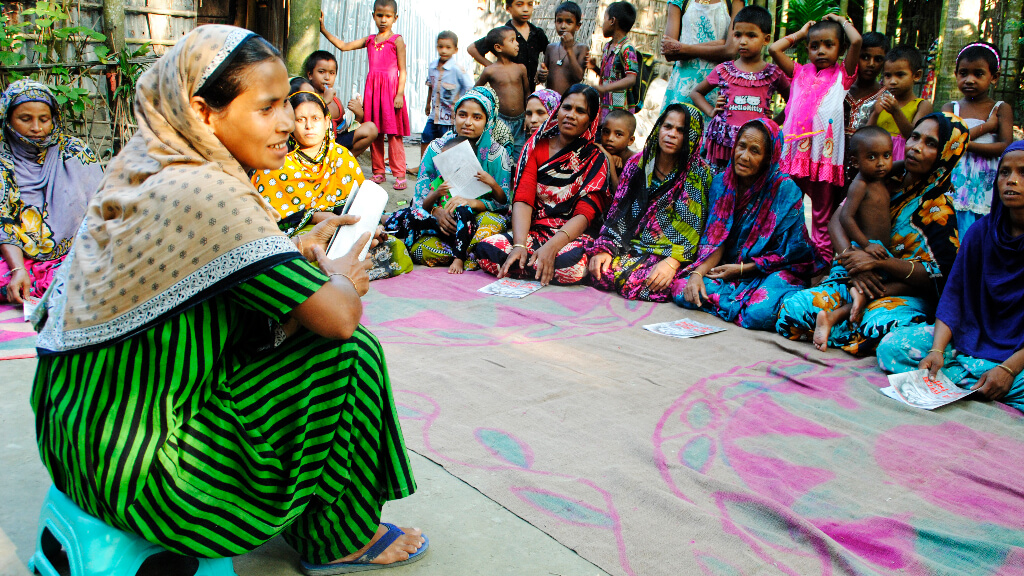While more than 40% of all animators are women, the need to take powerful action to transform the prevailing patriarchal marginalization of women led to the creation of a Women’s Leadership program — providing local women with an initial 3-day foundation course on gender issues and then monthly follow-up trainings on specific gender issues such as gender-based violence, child marriage, constraints on women’s employment outside the home and other issues.
Candidates for the Women’s Leadership program are typically somewhat more educated women — often teachers or female elected representatives — who are already well-respected in their village. This puts them in a unique position of being able to reach adolescent girls and young women who are confined to their households, through court-yard meetings. At these meetings, Women Leaders can engage the entire family on these sensitive gender-related issues.
The local cadres of women leaders are federated upwards to the upazila, district and national levels through the Unleashed Women’s Network (bikoshitonari.net).
Women Leaders Foundation Course
Purpose of the activity
- To organize, empower and invigorate a group of women in order to develop women leadership with an aim to create a hunger and poverty free, selfreliant Bangladesh by achieving gender equality.
Facilitation: what type of person or team is required to facilitate the activity?
- Staff from THP Training Unit
- THP regional staff
**A team of 2 to 3 facilitators is required for the course.
Preparation: what should be done before the activity?
- Selection of participants from ward level
- Finalization of a date, time and venue
- Inviting the participants to attend the course
- Logistics arrangement
- Venue preparation
- Preparation of the facilitators before the training (e.g. forming the team and dividing the responsibilities)
Participants – who should participate? How many in each session?
- Selective women from different backgrounds (such as elected representatives, social workers, service holders, housewives, community leaders, etc.) who are active in community level.
**30 to 45 participants should be present in each course.
Duration: how long does it take?
- It is a 3 days long residential course.
Financial cost items
- Materials
- Food
- Venue
- Accommodation
- Conveyance for the participants
- Facilitators’ cost
- Communication cost
What are the “transformative” aspects of this activity? It shifts the mindset of participants from what to what?
- The participants start to believe themselves as the change makers to mitigate gender related social issues
- They discover the desire and spirit within themselves to awaken, enlighten and inspire other women
- Upon participation in this meeting, the mindset of the participants shifts
- From accepting the ill fate of being a woman to raising voice and protesting against genderbased discrimination
- From the idea of impossibility of changing the situation to the possibility of achieving a better future
What are the content/factual learning objectives of the activity?
- To gain a clear concept regarding gender, role of gender and discrimination against gender, and be able to describe & analyze them
- To realize the real scenario of the financial and social reparation of women in Bangladesh, caused by the existing problems and gender discrimination, and be inspired to start a social movement by prioritizing the women issues
- To realize that the inferiority and stagnation of women is crated and reared by the existing male dominated structure and values, and be able to challenge these patriarchal values and mindsets in the issue of women empowerment
- To have an idea about the human rights and constitutional rights of women, review the government initiatives for the development of women, and ensure women’s accessibility in availing the services provided by the government
- To gain the skills to organize, manage and followup some workshop, dialogue and training to prioritize the gender issues between males and females in different levels of the society
- To take the responsibility of their own areas to empower women and make action plans in light of their expectations
Flow: from “welcome” to “thank you” what are the spaces the participants are taken through? If there are “power questions” that prompt each step, what are they?
- Welcome speech
- Expectation and aim of the training
- Introduction and rules of the event
- Concept of gender
- Role of gender
- Gender discrimination
- Demerits of gender discrimination
- Reasons for the subservience, powerlessness and stagnation of women
- Women empowerment
- Women development: International and national initiatives
- CEDAW Certificate
- The role of leadership
- Creating vision
- Making and sharing of action plans
- Closing
Followup: what should happen after the activity and how will we record it?
- Followup planning meeting
- Collection of the data (result/achievement/failure)
- MIS entry of the collected data
- Preservation of documents (hardcopy and softcopy)
- Publication of books on their success stories


